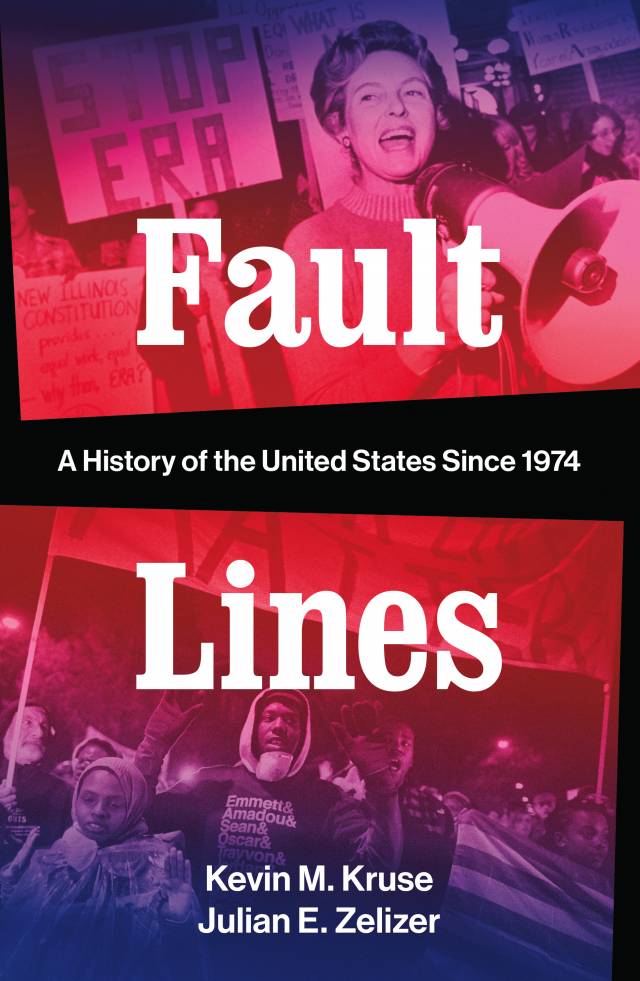Princeton faculty members Kevin Kruse and Julian Zelizer are well-known for their efforts to explain U.S. history and current events to the broad public.

Kevin Kruse
Kruse, a professor of history, turns to Twitter to lay out the facts of history in a rapid-fire media cycle. He also occasionally takes on prevaricating online pundits.

Julian Zelizer
Zelizer, the Malcolm Stevenson Forbes, Class of 1941 Professor of History and Public Affairs in the Woodrow Wilson School of Public and International Affairs, is a CNN political analyst and a noted commentator in international and national media on contemporary politics. His weekly “Politics and Polls” podcast with Sam Wang, a professor of molecular biology and the Princeton Neuroscience Institute, provides analysis of the latest political headlines and trends.
Now, Kruse and Zelizer have written “Fault Lines: A History of the United States Since 1974,” exploring the divisive domestic politics that have come to characterize the last 40 years of U.S. history. Published this week by W.W. Norton & Company, “Fault Lines” pinpoints the country’s entrenched political polarization to the mid-1970s, a time when Kruse and Zelizer argue multiple rifts began to occur in the social order.
Kruse researches the political, social and urban/suburban history of 20th-century America, focusing on conflicts over race, rights and religion. His previous books are “One Nation Under God: How Corporate America Invented Christian America” (2015) and “White Flight: Atlanta and the Making of Modern Conservatism” (2005).
Zelizer studies American political history, also specializing in the 20th century. He is the author of numerous publications; his previous book is “The Fierce Urgency of Now: Lyndon Johnson, Congress, and the Battle for the Great Society” (2015).
Together they describe how a deepening disunity over decades has impacted American politics.
How did your collaboration on this topic begin and develop?
The collaboration started as a course here at Princeton. Kevin had long been teaching a course on “U.S. History since 1920,” in which the past four decades were dealt with in a few cramped weeks. We decided that the time had come to create an entirely new course that looked at those decades as a discrete period in their own right, not as some sort of coda to the more famous stories of the mid-20th century. We taught the course together twice, and it became the basis for the book.
Why were the 1970s a pivotal point for polarization in American politics?
We feel that during the 1970s many of the foundations of today’s country took form — the increasing polarization of the parties, the fragmentation of the media landscape, the rise of economic inequality, the origins of mass social movements that pulled the country in different directions. Although any one year would be an artificial starting point, the resignation of President Nixon in 1974 really proved to be a turning point that helped move us into this new era.

Kruse and Zelizer’s new book, “Fault Lines: A History of the United States Since 1974,” examines the characteristic divisiveness of modern American politics.
Why haven’t these strains on American political life and unity resolved themselves?
That’s a major theme in the book. First of all, these divisions are deeply rooted in our institutions and widespread in our society, and can’t be easily overcome. Second, as we note at several points, there have increasingly been incentives for different political actors not to resolve these issues — things like partisan news outlets which present viewers a worldview that discourages compromise, or gerrymandered congressional districts which lead politicians to push their politics to the extremes rather than reach across the aisle.
How have these divisions culminated in the presidency of Donald Trump?
We see President Trump as the product of the era we wrote about. We finished a full draft of the book before he was elected and, of course, neither of us knew that he would be the next president. While we’ve added a concluding chapter that covers the election of 2016 and his presidency, we did so on an understanding that the developments of those years — pivotal though they are — really stemmed out of the forces we had already been tracking across the previous four decades. Themes in which we had already invested a great deal of energy, such as hyper-partisanship in politics or the impact that a fractured media landscape might have on society, were simply echoed and amplified in the Trump era.
Your students soon will enter the world created by these rifts. Do you get the sense that they will begin to heal them?
That’s a hard question for historians to answer, as our training has us looking back not ahead. But yes, there’s potential here for a great generation. Just this year — in one of the most contentious periods — we’ve seen how young people organized and mobilized, putting issues like gun control on the national agenda and proving themselves to be a force in the midterm elections. If they can maintain that kind of civic engagement, then they can do a lot to bridge the gaps that have grown over these previous four decades.





